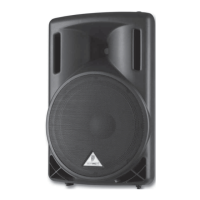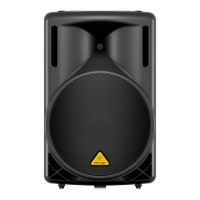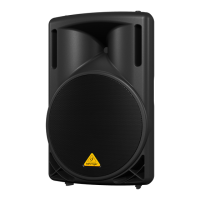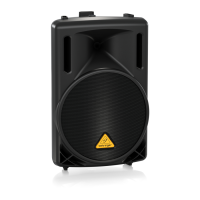8 EUROLIVE B2520 PRO/B1800X PRO/B1520 PRO/B1220 PRO User Manual
7. Troubleshooting
7.1 No signal when loudspeaker is connected
• Make sure that your mixing console is indeed carrying a signal (is the master
fader raised? Are channels active?) and that the gain control on your amp is
turned up
• When using a crossover, make sure that the relevant channels are active
• Check if the cable connection is interrupted/damaged somewhere in
yoursetup
• To test your conguration, connect another amp. If you now get a signal,
thepower amp is the culprit
• To test your conguration, connect another speaker. If you now get a signal,
the fault lies within the speaker
7. 2 Signal present only on one channel
• Make sure that your mixing console is working properly (is the signal present
on both outputs (L/R)?)
• If using a crossover, check if the relevant channel is active
• Check if the cable connection to the silent channel and to the corresponding
speakers is interrupted/damaged somewhere along the path
• Connect the silent loudspeaker onto the amp channel that works properly.
Ifyou now get a signal, it is the amp channel that is at fault. If you still
can not hear anything, the fault lies either within the loudspeaker or the
cablesused
7. 3 Signal distorted
• Make sure that all signals on the mixing console have been set to optimal
levels in order to avoid distortion
• If using a crossover, check if all signals have been set to correct levels
• Make sure that the power amp channels are not overdriving. If so, turn the
gain control down a little. However, it could also be the case that your power
amp doesn’t have enough power headroom, so that the required volume can
not be generated without starting to distort
• Make sure that the level of the signal getting into the speakers is not too
high, causing distortion
• Check your EQ settings. Excessively increasing the frequencies can result
indistortion
• If distortion is still occurring despite everything you have tried to eliminate
it, try connecting a dierent power amp. If you no longer hear distortion,
itscause was with the power amp
• As a test, connect another speaker. If you no longer hear distortion, its cause
was with the loudspeaker (perhaps a defective loudspeaker)
• Check if the cable connection is interrupted/defective somewhere along
thepath
7.4 Treble signal too low
• Check the EQ settings on your mixing console or on an external EQ,
ifapplicable
• Make sure that the tweeters on your loudspeakers are positioned at the
same height as the ears of the people in the audience. If not, please modify
the speaker position
• The internal tweeter fuse may have opened. In this case, please contact a
BEHRINGER service branch oce near you
7. 5 Bass signal too low
• Check the EQ settings on your mixing console or on an external EQ,
ifapplicable
• Check the speaker cable pin assignment (see g. 1.3). Incorrect pin
assignment can cause phase cancellation and the frequency incursions
related to it
7.6 Poor sound characteristics
• Check the speaker cable pin assignment (see g. 1.3). Incorrect pin
assignment can cause phase cancellation and the frequency incursions
related to it
• Check if large objects (e.g. eect racks and similar equipment) areplaced
in front of the loudspeakers. They too can negatively inuence
sounddispersion
• Check the sound quality of the input signal by listening to it on a set
ofheadphones
• Also see the instructions in the chapters 7.3, 7.4 and 7.5
